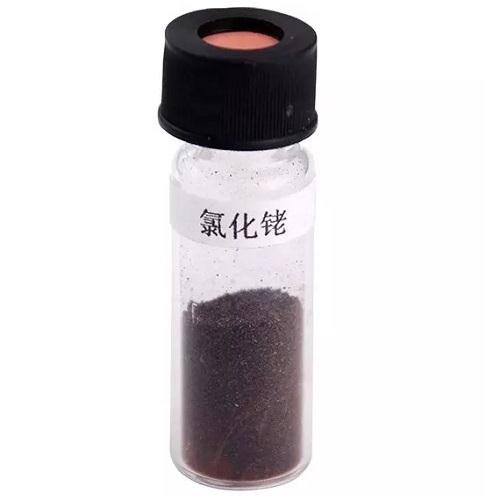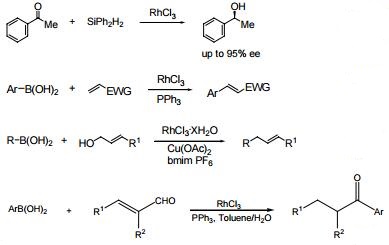Rhodiumtrichlorid Chemische Eigenschaften,Einsatz,Produktion Methoden
R-S?tze Betriebsanweisung:
R22:Gesundheitssch?dlich beim Verschlucken.
R41:Gefahr ernster Augensch?den.
S-S?tze Betriebsanweisung:
S36/39:Bei der Arbeit geeignete Schutzkleidung und Schutzbrille/Gesichtsschutz tragen.
S26:Bei Berührung mit den Augen sofort gründlich mit Wasser abspülen und Arzt konsultieren.
S24:Berührung mit der Haut vermeiden.
Chemische Eigenschaften
Rhodium(III) Chloride, also known as rhodium trichloride, is a red-brown or black crystalline powder that is easily deliquescent. poisonous! Molecular weight 209.26 (anhydrous), melting point 450~500°C (decomposition). Boiling point 800°C (sublimation). To 600°C above to generate polyfluoride. It can be reduced by hydrogen at 70°C. Insoluble in water, acid, aqua regia, soluble in methanol and cyanide solution. In concentrated acid (nitric acid, sulfuric acid) heating decomposition. When heated, it can interact with metals such as sodium, aluminum, magnesium, and iron.

Physikalische Eigenschaften
Brownish-red powder; deliquescent; decomposes on heating at 450 to 500°C; sublimes at 800°C; insoluble in water, water-solubility, however, depends on the method of preparation; soluble in alkali hydroxide or cyanide solutions; soluble in aqua regia
The trihydrate is a dark red powder; deliquescent; loses water at 100°C; very soluble in water; soluble in alcohol and hydrochloric acid; insoluble in ether.
Verwenden
Rhodium(III) Chloride is used in homogeneous catalysis, for example in the industrial prodcution of acetic acid. It is used to coat optic fibres and optical mirrors, and for crucibles, thermocouple elements and headlight reflectors. manufacture of rhodium trifluoride.
Application
Rhodium(III) chloride precursor may be used to dope graphene with Rh nanoparticles to prepare hybrids for electrocatalysis in energy, sensing and biomedical sectors. It can be used to prepare [Rh(NH3)6]Cl3.
synthetische
Rhodium trichloride is prepared by heating rhodium with chlorine gas at 250°C:
2Rh + 3Cl
2 → 2RhCl
3Also, the chloride salt may be obtained by treating the yellow hydrous oxide, Rh
2O
3.5H
2O, with hydrochloric acid. The solution is carefully evaporated to form a dark red and water-soluble salt, rhodium trichloride tetrahydrate, RhCl
3.4H
2O. Heating the tetrahydrate in a stream of hydrogen chloride gas at 180°C forms the anhydrous salt, RhCl
3.
Reaktionen
Catalyst in conjunction with "pybox" for the asymmetric hydrosilylation of ketones.
C-C bond forming reactions.

Hazard
Toxic by ingestion.
Sicherheitsprofil
Poison by ingestion, intraperitoneal, and intravenous routes. Experimental reproductive effects. Questionable carcinogen with experimental carcinogenic data. Mutation data reported. Incompatible with pentacarbonyl iron + zinc. When heated to decomposition it emits toxic fumes of Cl-. See also RHODIUM and CHLORIDES
m?gliche Exposition
Rhodium trichloride is used in hydrosilylation, hydrogenation, carbonylation, oxidation, arylation. See also “Rhodium Metal.” In plating operations and in catalyst preparation, the metal will be used as the trichloride.
Versand/Shipping
UN3260 Corrosive solid, acidic, inorganic, n.o.s.,
Hazard class: 8; Labels: 8-Corrosive material, Technical
Name Required.
l?uterung methode
Probable impurities are KCl and HCl. Wash the chloride well with small volumes of H2O to remove excess KCl and KOH and dissolve it in the minimum volume of conc HCl. Evaporate it to dryness on a steam bath to give wine-red coloured RhCl3.3H2O. Leave it on the steam bath until the odour of HCl is lost-do not try to dry further as it begins to decompose above 100o to the oxide and HCl. It is not soluble in H2O but soluble in alkalis or CN solutions and forms double salts with alkali chlorides. [Anderson & Basolo Inorg Synth VII 214 1963.]
Inkompatibilit?ten
Sensitive to humidity. Incompatible with
oxidizers (chlorates, nitrates, peroxides, permanganates,
perchlorates, chlorine, bromine, fluorine, etc.); contact may
cause fires or explosions. Keep away from alkaline materi-
als, strong bases, strong acids, oxoacids, and epoxides.
Waste disposal
Recovery and reclaiming
wherever possible in view of high economic value. See
“Rhodium Metal.”
Rhodiumtrichlorid Upstream-Materialien And Downstream Produkte
Upstream-Materialien
Downstream Produkte

